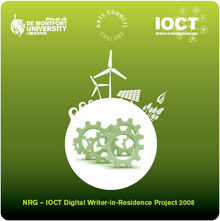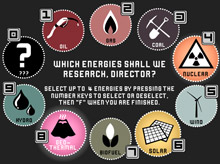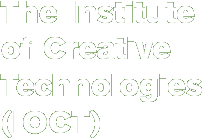  |

A bike-powered interactive fiction by Chris Joseph This version 10/2008 Please note that NRG was designed as an offline installation, so loading may be very slow. |
|
It's 2010 and you have been appointed to lead the new World Energy Directorate, with the power to control international spending and research on energy sources and production. Your decisions will influence the life of billions of humans, countless species and the Earth as a whole. How will your choices change all our lives during the planet's next forty years of industrial development? Part environmental game, part multimedia artwork, NRG (short for En-er-gy) is a self-sustaining, people-powered installation. No previous knowledge about energy issues is assumed or required, but NRG is intended to stimulate thought and discussion about energy consumption, global warming and the need for the development of lifestyle alternatives. NRG was created by Chris Joseph as part of the first Digital Writer in Residence position at the Institute of Creative Technologies (IOCT), De Montfort University, Leicester, UK. |
 |
|
Over the past century the electronic explosion helped create many wonderful new worlds within art, and this transformation continues to gather pace, just as it does everywhere else in society. Yet unlike painting or sculpture, electronic art is perpetually greedy for power, and this has traditionally meant that natural resources (converted to electricity) are required for the work to be experienced by both physical and virtual audiences. As an electronic artist, this dependence has always made me uneasy, and raises important economic and moral question at the heart of digital art: is the art (or is any art) worth a continuing exploitation of the world's scarce resources? This question seems to be rarely explored within electronic art itself. So in my brief to responding to the IOCT, an institution at the forefront of electronic creation and theory, it seemed natural to focus on energy, both as a narrative theme and in the practical realisation of the piece. Thus my starting point was to create a self-sustaining piece of electronic art; that is, beyond the resources used to create it, a piece that wouldn't require any additional power to experience it. The idea of using bicycle power sprang from discussions with a group of art-activists in Cambridge called Magnificent Revolution, who have been putting on cinema shows at festivals powered by a 'battery' of 10 people on bikes. The technology behind the bike generator is actually a very simple. As you pedal, the bike's rear wheel spins the generator, a spinning magnet within a coil of wire. As the magnet spins within this coil, electricity flows through the coil, and out through the wires. The average person creates between 100 to 250 watts, depending on their strength. What I really like about this method of power generation is that it is incredibly striking and immediate. A pedaler can very quickly gain an understanding of the huge amount of human effort that would be required to power our daily lives if it weren't for the continued burning of fossil fuels which are still our primary energy source (over 80% of primary energy production in the world still comes from burning oil, coal and gas). Most of my research for this project certainly made extremely depressing reading. As you probably already know, many scientists believe that we have already passed an environmental tipping point, so that even if we started today to move away from fossil fuels as fast as we could, the damage to our environment would still get worse for another 20-30 years before it started to improve again. The reality is that change is coming much too slowly, and it seems the only real political and personal impetus to change will be the running out of oil, which many analysts believe will occur within our lifetimes. If we don't move more quickly to develop sustainable energy alternatives, the result will be at best some serious shocks to our quality of life, and at worst irreversible damage to the world ecosystem and economy that will cause shortages, famines and wars over the remaining diminishing resources. However there are plenty of clever people out there exploring alternatives to fossil fuels, and this is something I wanted to look at in the fiction element of the piece. I certainly didn't set out to make a 'science fiction', but if sci-fi is about speculations based on current and future science and technology, that's exactly what NRG turned out to be. There were some major challenges with this besides the continually gloomy research. Firstly, trying to make sense of the numerous complex and contradictory statistics, projections and scientific opinions that exist in the wonderful world(s) of energy theory. If you have some time and are interested I recommend having a look at some of the links or books I have listed at the bottom; if you are pressed for time then I would suggest Paul Roberts 'The End of Oil' for some very measured and extremely depressing reading. In the end I made a conscious choice to go with the most popular assumptions about energy use and alternatives, bearing in mind that, as with any science-fiction, there is a great chance that these could all be proved wrong. The second challenge was how to convert the mass of data and alternative projections into a piece that makes the user think - or at least start to think - about the choices and issues, within a very short 4-5 minute installation experience. It's never going to be easy to get people to listen to bad news, even less when the bad news is followed up by a range of complex and costly possible solutions, but it is the major challenge for alternative energy advocates and environmentalists all over the world to find ways to make people and their governments change their energy policies. Sadly, it may only be shock rises in power prices that will finally make people sit up and take notice, rather than the state of the world's environment or its rapidly shrinking biodiversity. My solution to this second challenge was to simplify and exaggurate all the realities to create clearer (if fantastic) fictional scenarios, such as terrorist attacks, massive deaths due to smog, and a linear path of breakthroughs when researching experimental new technologies. While the news items are fantastical, the baseline statistics in NRG are all within the realms of possibility, and are drawn from existing projections. In contrast to the simplification of solutions and results, I've tried to maintain a sense of the confusing and contradictory nature of the energy debate via an overload of media. While you play you will hear snippets of conversations from the 'experts' that remain tantalisingly the wrong side of useful. Your science advisor will bombard you with textual and visual data about each energy that is almost too fast to take in. And the measure of carbon emissions will return every decade to remind you of just how bad things (still) are. Through my responses to the design of technology and content, NRG became a kind of hybrid: part game, part multimedia art installation and part science fiction. As the leader of the newly established World Energy Directorate, the user chooses up to 4 energy sources per decade around which world investment will be focused. Over the subsequent decade these choices result in events that change the level of harmful carbon dioxide emissions, the size of the world's population and the overall energy use. Just as in the real world, the events triggered by your choices are subject to random influences, so even choosing the same strategy each time will result in a different end game result. For example, if you decide to invest purely in low carbon-emission energies such as wind, 'bad' things may still happen, such as anti-wind groups sabotaging wind farms due to their possible effect on bat populations. I have also included a basic version of the ratchet effect: this is the phenomenon noted in economics where it is easy to raise your spending after a rise in income, but much much harder to reduce it back to the previous level if your income falls again. The equivalent phenomenon in energy production is that it is very easy for us to increase carbon emissions, but much harder to reduce them back unless we invest consistently in a technology for several decades. This is because governments and companies concerned with the bottom line will wait for existing power plants to be retired before replacing them with environmentally better but more expensive alternatives. In NRG, higher carbon emissions are unambiguously bad, and lower emissions are good, as suggested by the colour of the spinning earth CO2 level animation, from a healthy green when emissions are low through dusty browns to a deathly red at high levels. It's possible that this is a Gaian ethos - framing NRG from the perspective of the earth as a living organism, rather than humans as such, though clearly that division is little more than wishful thinking. The same kind of value judgment is not suggested for population or energy use levels, as is perfectly rational to conclude that a lower human population is not only inevitable, but desirable, due to the ever-rising pressures on our planet's diminishing resources. However I leave those kind of ethical judgements up to the player. |
|
|
|





